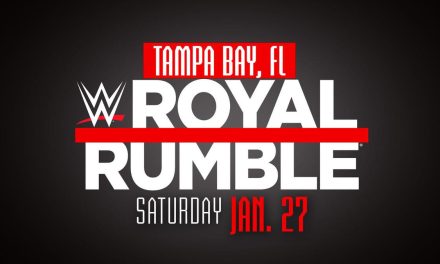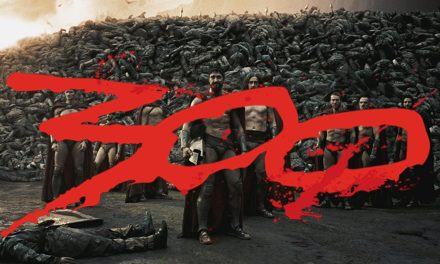
This past Monday night on the 10/19/20 edition of Monday Night Raw, Retribution went down like movie theater stock during a quarantine.
But that’s not where the troubles began, not even close. You might be tempted to think they began when the audience realized those masks weren’t coming off, or when they started talking like the 90’s comic book characters they were probably named after. But again, you still need to further back. Much further back, in fact, because this started long before Retribution was even a concept.
For what it’s worth, this isn’t going to be an article about what Retribution could have been. I’m not going to claim that if only they had different members or a different concept, or anything along those lines, because the truth of it is, if you really do a deep, forensic examination of what they’ve been there’s some really good stuff in there. From the very first time we see them setting things on fire, not directly attacking wrestlers but giving a sense of tension that they were here, and they could be dangerous. All the way to the last time we see them with Mustafa Ali saying the quiet parts out loud that WWE couldn’t market someone with his name, firing a point blank shot that the company he works for is racist. It’s all provocative. And it was always going to fail.
Heels And Faces Are Part Of The Show
What the WWE has always had, well back to the first Wrestlemania and for decades after, was the very simple concept of good guys and bad guys. Heroes and villains. Faces and heels. And fair play to them, they’ve done a tremendous job at times. But when it’s all in a vacuum, when you can pretend like the rest of the world doesn’t exist, the stakes can only ever be so high. Heel or face, whoever is champion of the company is still an employee of that company. So how then, do you make the stakes existential? How do we effectively threaten the audience with a paradigm shift? How do you effectively write a catosphere in a program that has worked for decades in part because of its formula? Okay, a simpler question: How do you make the problem bigger than just two professional grapplers?
With the Monday Night Wars between WWE (then WWF) and WCW, we had began to approach that answer, but at the end of the day for as good as it was for fans to have two companies compete for our attention, the stakes were still only a matter of which billionaire would get bragging rights and a few extra dollars for that week. But that changed when the unthinkable happened. Because if you were a kid like me, the idea that either WCW or WWE could definitely win never crossed your mind. If you were a kid at the time growing up on wrestling, seeing Shane McMahon appear live on Nitro to tell his father that he had bought the company was an utterly surreal moment.
Invasion Angles Take Special Care, And This One Didn’t Have That
But then there was also what you didn’t see. Without a full breakdown of the Invasion, there are a few key reasons it failed. We didn’t see the top WCW stars like Sting, Kevin Nash, and Goldberg for one thing, and though that’s perhaps unfair to blame on WWE, but what we can hold against them is what they did with what they had. At no point was WCW portrayed as an equal, and even with the addition of ECW to the story, the likes of Paul Heyman took a backseat to Stephanie McMahon. In the end, it wasn’t Vince against Eric Bischoff and Paul Heyman, it was a McMahon family feud with the climax being The Rock vs Stone Cold Steve Austin.
Fast forward some years to the Nexus storyline. If anything, this story had so much more depth than what we had from the WCW Invasion, because where previously the stakes had been to preserve something that was always going to last, in memory if nothing else, the Nexus were fighting for survival. If you don’t remember the premise, picture this: On NXT, good men who only want the opportunity to live their dream are pitted against each other with only one being allowed employment. The leader of the group, a man who was guaranteed a contract, rallies his fallen comrades to fight the system itself, vowing to not stop until everyone has what he’s earned.
And they made him the villain.
Nexus Worked For Awhile

Their intro was chilling. Pitch perfect. CM Punk against John Cena, when Wade Barrett comes out. He doesn’t do anything right away, but he’s noticed. Everything is uneasy. And then the members of Nexus hop the barricade. Cena throws Punk to the wolves, but they weren’t here to help Punk. They devour him quickly and move on. Cena is confused, but not for long. They surround him in the ring, and with a nod from Barrett they lay waste to him. But even this isn’t their end goal, they turn their attention to everything in sight. The commentary team, the time keeper, the very ring itself; the message is clear. If WWE won’t have them, there won’t be a WWE. For several long, uncomfortable minutes, the fans watch as these eight men dismantle everything.
So, what did they do with this amazing introduction? Almost immediately they made it about how one man could outsmart this entire group and make them look like chumps. It’s difficult to imagine now, but the first iteration of the Nexus didn’t last more than six months. And it of course ended with Cena burying Wade Barrett. Quite literally, in fact, he buried him under what looked like a hundred chairs.
WWE Has Already Shown Us Their Cards With This One

And if this is why we’ve been ambivalent about the next invasion, it’s because we’ve seen it before, and we know how this all ends. It’s been watered down each time, as well. They’ve gone from possibly destroying the industry, to ruining a ring, to setting fire to a trash can. It’s gone from the stars of a rival promotion, to the young hopefuls of tomorrow, to a handful of people whose names you don’t know and who are probably better off not showing their faces.
Here’s a test for you: You’ve been reading an an entire article about Retribution and the invasions that came before it. Without looking them up, can you name them all? Can you match the fake names to the wrestlers? Could you point at a picture of Retribution and say with confidence which one is T-Bar?
And that’s the problem. Even if you could, it doesn’t feel like a celebratory moment, does it? And you know full well that most people couldn’t. So when we see them jobbed out twice in one show, it’s not a surprise. They’re not going to achieve their goals, they’re never going to pose a threat, and by this time next year no one will even remember this happened. They’re a bad joke, and that sucks. Because in capable hands, this story is the one the company needs.



